FDA’s Breakthrough Therapy Designation
Pharmaceutical Executive
Three key questions dominate the agency’s Breakthrough Therapy Designation program since its 2012 launch.
Three years on ... and three key questions
The Breakthrough Therapy Designation (BTD) came into force in July 2012 after the Food and Drug Administration Safety and Innovation Act (FDASIA) was approved by Congress. FDASIA Section 902 provided for a new designation for drugs that treat a serious or life-threatening disease or condition and for which preliminary clinical evidence indicates the drug may demonstrate substantial improvement over existing therapies on one or more “clinically significant” endpoints.
Early on, BTD seemed a fairly unremarkable addition to FDA’s stable of expedited development and approval programs. Expectations for its impact
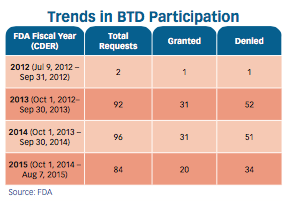
were not dramatic, perhaps as few as two to three designation requests per year. However, according to FDA’s 2013 Industry Guidance report, just a year after the legislation came into force, that estimate had risen tenfold. Today, three years into the BTD program, that initial estimate appears to have been off by 30- or 40-fold (see chart at right).
Question one: Is BTD living up to its billing?
Similarly, at first glance, the BTD looked like just another version of Fast Track, a separate FDA drug review designation. However, the agency was quick to note the benefits of the BTD are more expansive than Fast Track, explaining that the program provides for “intensive guidance on efficient drug development … beginning as early as Phase I,” with specific recognition of advances in clinical trial design, such as adaptive clinical trials, as well as evolving technology, such as companion diagnostics. Most notably, the BTD offers the sponsor “our organizational commitment, involving senior managers,” which has been likened to an “all hands on deck” call for collaborative, cross-disciplinary engagement by the FDA, not just at the division level but across all levels of management.
Therein, however, lies one of the challenges soon discovered by FDA and sponsors. On the part of FDA, it is something the agency has experienced before-too much, too soon. The answer so far has been a commitment to flexibility. Agency reviewers are agreeing to less stability data at submission, accepting amendments during the review cycle, and increasing post-marketing commitments. Going forward, FDA has indicated a willingness to extend that accommodation further upstream in the process.
Roughly 72% of the BTD denials relate at least in part to trial design or analysis problems, which suggests that sponsors must do more to engage with FDA prior to submitting their request. Though there are several formal mechanisms for interacting with the agency, informal consultations with the relevant review division could help sponsors get a better and much earlier sense of what kind of data FDA might need. Speakers at a recent Brookings Institution meeting noted that such early communication could both strengthen viable BTD requests and reduce the number of frivolous requests.
The call for “all hands on deck” goes for drug sponsors, too, who are facing similar challenges in terms of resources. Market applications are being filed after Phase II, two years ahead of the traditional new drug approval (NDA), a situation further complicated by simultaneous application in a number of markets globally (involving foreign facility site inspections). For biologics, the BTD may involve filing with broader specifications that get tightened up post-launch, launching from the clinical site, and transferring to commercial production sites post-launch, thus having to include a post-approval lifecycle management plan in the application to support deferral of certain activities.
The challenge is that companies can’t place bets on potential breakthroughs too frequently without overly straining company resources. FDA also has to worry about straining company resources, since the program continues to grow in popularity (the chart above indicates that by the close of fiscal year 2015, there may be another 100 requests in line), and the enabling legislation did not provide a funding mechanism sufficient to meet the additional demand. Suggestions for reducing the number of requests have drawn on previous FDA tactics, such as requiring application fees or publicizing failed requests.
Question two: Is a BTD worth it?
What does a sponsor get if “the bet” pays off? In short, a lot! On average, total development time for BTDs (n=11) in 2013 and 2014 approved as new molecular entities (NMEs) was 2.5 years less than non-BTD NMEs (n=53) (see chart). This benefit held up
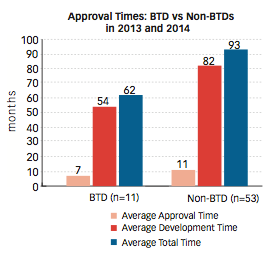
regardless of whether or not the drug cohorts being compared had also been granted special status under other FDA programs such as accelerated approval or orphan product designation. In other words, the BTD by itself resulted in almost a 3.5 year advantage (see chart below).
This early showing on the part of the BTD has not gone unnoticed by the investment community. Dollars invested into life sciences companies
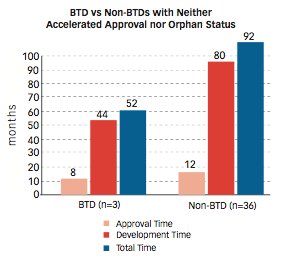
accounted for 18% of total venture capital investments in 2014. Venture capitalists, alone, invested $6 billion into private biotechnology companies. Congressional testimony vaunts that private investment trends are a result of a positive regulatory and policymaking environment for the biotechnology and pharmaceutical arenas, with one particular example being the success of FDA’s BTD.
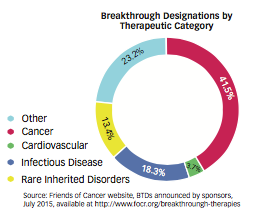
At the same time, patient groups must be pleased with the program’s output: over 300 designation requests and over 25 approvals in three years (including both NMEs and supplements at the Center for Drug Evaluation and Research (CDER) and the Center for Biologics Evaluation and Research CBER) across a number of therapeutic categories (see chart at left).
Question three: Is there a larger public health benefit?
FDA, itself, has noted that the impetus for the designation could be traced to several emerging trends in drug discovery and development, such as the rise of molecularly targeted therapies, often paired with companion diagnostics. Some of these targeted therapies achieve a much larger treatment effect than currently available therapies- effects that are obvious even in the initial trials in humans. When a large effect in a serious disease is observed early in drug development, it seems excessive to conduct a prolonged clinical development program that encompasses traditional trial phases.
FDA is already being challenged to provide access to promising therapies earlier than its traditional process allows, especially when no other therapy exists. This would seem like a path more in line with FDA’s mission to protect public health while promoting medical product development. By requiring that the drug demonstrate substantial superiority over available therapies on a clinically significant endpoint, it provides both a meaningful advantage over available therapies and evidence that reasonably predicts clinical benefits.
Thus, it allows FDA a means to address what it has called the regulatory paradox, an inherent but reconcilable tension between aversion to uncertainty and willingness to accept certain unknowns about a drug before approval. By evolving away from periodic intervention at critical junctures in drug development to an “all hands, all decks, all the time” facilitative framework, FDA can support medical innovation from early clinical testing through post-market risk management. In order for that to happen, however, something will have to give on the resources front. The choice is clear: either sponsors will have to have scale down, with fewer or better quality submissions, or FDA will have to scale up by expanding the program and charging fees.
Chistopher-Paul Milne is Director of Research, Tufts Center for the Study of Drug Development (CSDD). He can be reached at christopher.milne@tufts.edu.
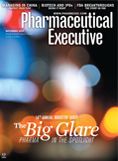
FDA Grants Priority Review to Regeneron’s Eylea for Macular Edema Following Retinal Vein Occlusion
April 18th 2025Regulatory action was based on data from the Phase III QUASAR trial, which demonstrated that Eylea HD dosed every eight weeks achieved non-inferior visual acuity outcomes compared to Eylea in patients with macular edema following retinal vein occlusion.
Navigating Distrust: Pharma in the Age of Social Media
February 18th 2025Ian Baer, Founder and CEO of Sooth, discusses how the growing distrust in social media will impact industry marketing strategies and the relationships between pharmaceutical companies and the patients they aim to serve. He also explains dark social, how to combat misinformation, closing the trust gap, and more.